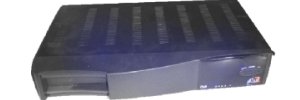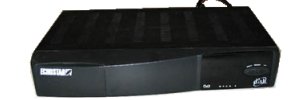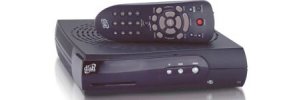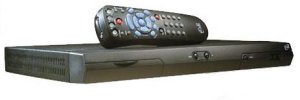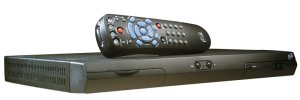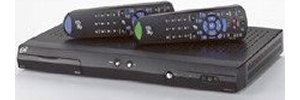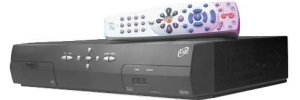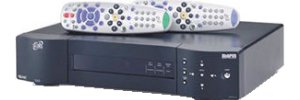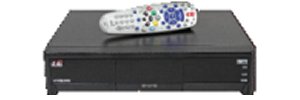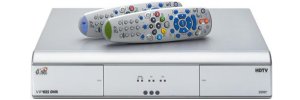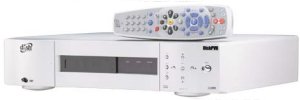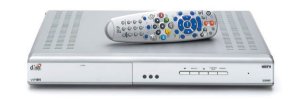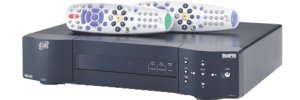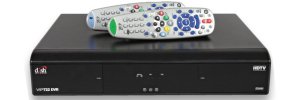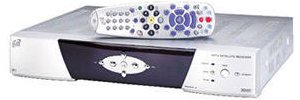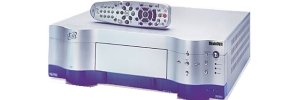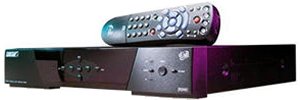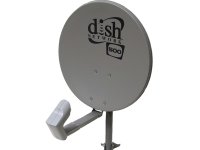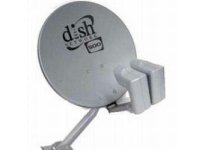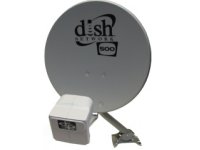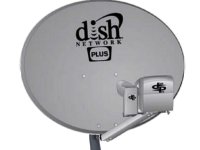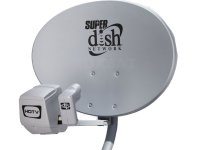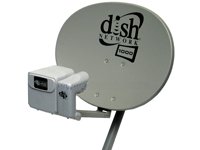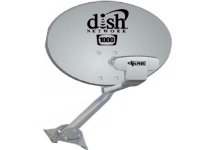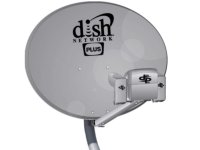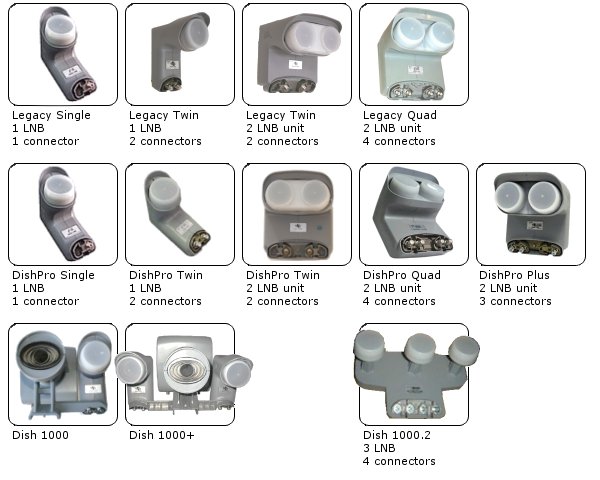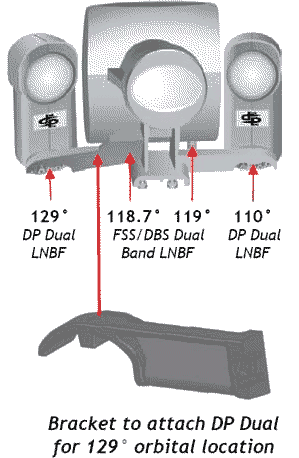Receivers
Model 2800
2800 Legacy SD Single-Tuner IR Receiver
Model 3900
Model 111 DishPro
Entry-level compact satellite receiver often used for add on televisions in the home.
Model 301
A very common entry level receiver often bundled with Dish 500 systems. The smart card is removable.
Model 311
Same as the model 301 except less desirable because the smart card is built in. There is still a slot for adding a new smart card if and when Dish Network distributes them.
Model 322 Dual Tuner
Dual tuners means you can have two TV sets connected for viewing two different channels simultaneously; for TV in another room. Use RF remote for around home control.
Model 501
Receiver and DVR combination unit.
Model 508
Essentially the same as model 501.
Model 510 DVR
Receiver and DVR combination unit with extended storage, 120gb drive for approx 100 hrs.
Model 522 DVR
Dual tuner receiver and DVR combination unit with extended storage, 120gb drive for approx 100 hrs.
Model ViP612 DVR
Model ViP622 DVR
Model 721 DVR
Dual tuner receiver and DVR combination with advanced pause live TV capabilities, PIP, 120gb drive.
Model ViP211
Model ViP222
Model 625
Model ViP722 DVR
Dual tuner HD receiver with DVR.
Model 811
"Player" Model 921 DVR
Dual tuner satellite receiver with DVR combined SD and HD with PIP. Video on demand, pause live TV, 250gb drive, up to 180 hours, RF remote standard.
Model 6000U
720p or 1080i HDTV receiver. Outputs 720p or 1080i HDTV resolutions. SD and HD.
Dishes
Dish 300 Single
Legacy Dual Ouput LNBF and 18 inch round dish. Use to receive from 61.5 or 148 degree echostar. Can also add to a Dish 500 setup using Twin LNB and a DP34 multiswitch to distribute 101, 119, and 61.5 satellite. Some have Winegard printed on the dish face. Optimized for Dishnetwork, ExpressVU. One LNB allows two receivers to be connected. This original Dish Network dish design, used to receive programming from a single high powered DBS-band satellite, is now mostly in use by customers requiring the use of a second dish in order to receive local programming.
- 18" : 110°
Dish 500 Dual Single LNBs
The first Dish 500 Dishes used two-single LNBs for a one receiver system. This Dish 500 with two Dish pro single LNB's will receive signals from Echostar 7 (110) and from Echostar 6,8 (119). A Dish 500 Dual installation may use DP (Dish Pro) LNB types or two Legacy LNB types. Either allows a receiver to get signal from both the 119 LNB and the 110 LNB. Dish network developed the SW-21 Switch for combing the signal from the two separate LNBs. Note that even with the dual DP LNBs the SW-21 switch is still required. The SW-21 Switch is a digitally controlled A/B switch.
- 18"x23" : 110°, 119°
Dish 500 Legacy and Pro
Made for Dish Network by Winegard with either Legacy Twin or Dish Pro (DP) Twin LNBs used to pickup the Echostar 110 and 119. The Pro Twin LNB features a built-in DP21 videopath multiswitch compatible with all newer "DishPro" receivers. Older units equipped with they legacy twin LNB, newer equipped with DishPro Plus twin LNB. Units may also be available with the old Legacy Quad, which still received from two satellites but allowed for a total of four receivers. There is also a Dish Pro Plus (DPP) LNB type which receives from two satellites but has an input allowing for a third LNB to be added, see Dish Pro Plus below.
- 18"x23" : 110°, 119°
Dish Pro 500 Plus
Dish 500+ adds a third LNB. Receive from satellites 110°, 119° DBS-band and the 118.75 FSS Ku-band satellite. This dish replaces previous 500 models which could not do the 118.75 satellite.
- 20"x24" : 110°, 119°, 118.7°
Super Dish 105
Can receive from 3 satellites, replaces earlier Dish 500 which could only receive from 2. The 105 SuperDISH is pointed to receive signals from Dish Network satellites at 105, 110, and 119 degrees West. SuperDish was the first design by Dish Network to receive satellite programing from the core 110/119° DBS-band satellites and also programming from either the 105° or 121° FSS Ku-band satellites. Local programming for selected markets were originally broadcast using the FSS Ku-band satellites. Recently, Echostar has migrated many local markets to the new 118.75° satellite to allow most U.S. customers to receive it as well as nationwide high definition programming from a single dish. Currently, there remain a few selected local channel markets that require the use of a SuperDish to receive local channels. These markets will require a second dish if they wish to receive high definition programming.
- 36"x20" : 105°, 110°, 119°
Super Dish 121
Can receive from 3 satellites, replaces earlier Dish 500 which could only receive from 2. The 121 SuperDISH is pointed to receive signals from Dish Network satellites at 110, 119, and 121 degrees West. Appearance nearly the same as 105. Just like the 105 the 121 is a legacy dish.
- 36"x20" : 110°, 119°, 121°
Dish 1000
DISH 1000 legacy provided reception from the 110, 119 and 129. Replaced by Dish 1000.2.
- 20.5"x22.5" : 110°, 119°, 129°
Dish 1000.2
The Dish 1000.2 antenna gives you the advantage of receiving more programming (such as HD) using a single dish solution. Reception from 110, 119 and 129 and allowing 3 receivers. Can also add a second dish. International programming from 119 available. 3 outputs DISH Pro separators can be used to create up to six outputs from the dish. Compatible with DISH Pro single-orbital LNBFs or DISH Network bandstacked LNBFs, and DISH Pro Plus 44 switch.
- 23.8"x30.9" : 110°, 119°, 129°
Dish 1000 Plus
The DISH 1000+ supports reception from 4 satellites. Includes a DP Dual Band LNBF and two DP Dual LNBF. The DP dual band LNBF receives 118.7 and 119 while the 2 DP Single LNBFs receive 110 and 129. Install using a DPP 44 switch. Works with any Dish Pro or Pro Plus receiver from Dish Network. Primarily used to receive nationwide high definition programming, delivered form the 129° satellite. The elliptical Dish1000+ design replaces the Dish1000 design, which did not receive the 118.75 FSS Ku-band satellite.
- 23.8"x30.9" : 110°, 118.7°, 119°, 129°
Dish Parts and LNB Information
Legacy LNB Explained
Dish Network uses a general type of LNB called a circular feed lnb. All of the following DBS providers use specific types of circular LNBs: Dish Network, ExpressVu, and Direc TV. With these circular LNBs not all are compatible across the DBS providers. ExpressVu and Dish Network are compatible.
This term is in reference to LNB switching that is necessary for receivers connected to more than one LNB. Remember, to receive from more than one satellite, more than one LNB was needed. Dish 500 introduced a dual LNB system. The receiver needed a way to switch between one LNB and the other, depending on what satellite a particular channel resided on.
The Dish 500 required a 2 in 1 out switch(SW21), and the 4 in 2 out (SW42) switch for the receiver to receive from two satellites (119 and 110). Then Dish Network came up with the legacy Twin 500 and the legacy Quad. This LNB's incorporated two LNB and internal switches, eliminated the need for external switches.
The switching system had to be further improved to accommodate the connection of more than four total receivers. This improvement is the Dish Pro (DP) LNB. The Dish Pro (DP) LNB takes the odd and even transponders and brings them both to the receiver at the same time. The old voltage switching control of the legacy LNB polarity became obsolete. With the new system the signal could be split to multiple receivers. However, the new Dish Pro (DP) LNB consumes the use of a full 1000 MHz or 1 GHz of bandwidth. Coax cable which worked Ok for Legacy installations may not meet the needs of a DP installation.
The Dish Pro LNB's are typically denoted by the letters DP or DPP on the side of the LNB. The Dish Pro (DP) LNBs basically convert all horizontal frequencies to vertical so the lnb handles only one polarity. This is easier to separate signal with DP splitter. If the Dish Network receiver is a legacy receiver, it will not work with the modern DP LNBs.
Both Legacy LNB Dish 500 and Dish Pro 500 are designed to receive satellite transmissions from 119 and 110. Twin and Quad legacy LNBs will connect up to four receivers. They have the SW21 for each output. These LNBs are designed to work for old receivers for Bell ExpressVu & Dish network. For ExpressVu the satellites are Nimiq 91W & Nimiq 82W. The newer DP LNBs will not work with older receivers, as stated above. Newer receivers should have the letters DP right on the front or top to indicate compatibility with modern DP LNB dishes.
LNB Types Explained (LNBF)
The term LNB and LNBF may be used interchangeably on DBS satellite systems. The F simply refers to "Feedhorn." The DBS systems use a small circular LNB that is combined with the feedhorn, making the LNB feedhorn combination denoted as LNBF, or just LNB. There is a common misconception that the presence of an F in the LNB acronym indicates a "legacy" LNB, this is NOT the case. LNB and LNBF are basically interchangeable. We choose to use LNB since it is abbreviated.
Single LNB: This refers to an LNB designed to support only one satellite receiver. It cannot be split to support more than one receiver at a time. It may be pointed to a single satellite in space.
Dual LNB: This refers to an LNB designed to support two satellite receivers, or more with the addition of a multiswitch. It is also referred to as the Dish Pro Dual LNB.
Legacy Twin: This unit is two circular LNB units inside one plastic housing with two outputs. The multiswitched signal combines both satellites 110 and 119 to be carried on a single cable. Two cables may be connected to this unit for two receivers. The Legacy Twin points to two satellites in space.
Legacy Quad: This unit also has two circular LNB units inside one plastic housing, except with four total outputs. The multiswitched signal combines both satellites to be carried on one cable, and up to four receivers may be connected, one cable per receiver. The Legacy Quad points to two satellites in space.
Legacy Dual: Two Single LNB units are mounted side by side, they are each in their own separate plastic housing. An external SW21 switch is needed to combine the signal from each LNB together. This is intended for supporting only one receiver. The SW21 is a legacy switch.
Dish Pro Twin: This unit is two circular LNB units inside one plastic housing with two outputs. Polarization is converted so everything is vertical polarity. The Dish Pro Twin will not work with older legacy receivers. Allows for the connection of more than four receivers. This unit points to two satellites in space.
Dish Pro Plus Twin: Like the Dish Pro Twin this unit is two circular LNB units inside one plastic housing with two outputs. Polarization is converted so everything is vertical polarity. The Dish Pro Twin will not work with older legacy receivers. The Plus refers to an additional input which allows for a third LNB to be added, for connections to 118.75 FSS Ku-band satellite in addition to 110 and 119 DBS band. Allows for the connection of more than four receivers. This unit points to two satellites in space.
Brief Summary:
The terms Single, Twin, and Quad refer to the number of connectors on the LNB unit, relative to the number of receivers that may be connected.
The term Twin is often erroneously used to describe the housing with two LNBs.
The term Dual is used to describe the double LNB in a single housing unit such as is on a Dish 500.
The term Plus typically indicates an additional LNB with the capability of receiving from more than two satellites.
Switches and the DisEqC
A dual has two coax connections. To allow a receiver to get signal from both the 119 LNB and the 110 LNB. Dish network developed the SW-21 Switch. The SW-21 Switch is a digitally controlled A/B switch. When the receiver want to tune to a channel on the 110 satellite, a digital signal using the DisEqC format was sent down the coax to the switch. Another signal was sent to switch back to 119.
Dish Network also came out with several additional switches for various applications. All the switches used the same DisEqC method. The SW-64 required an external power supply. The SW-64 was used to distribute signal from three satellites (usually 119, 110 and either 61.5 or 148) to as many as four receives. The 61.5 and 148 satellites are used for additional local channel channels, international programming and other niche market market programming.
Dish 1000+ LNB (LNBF) Assembly
